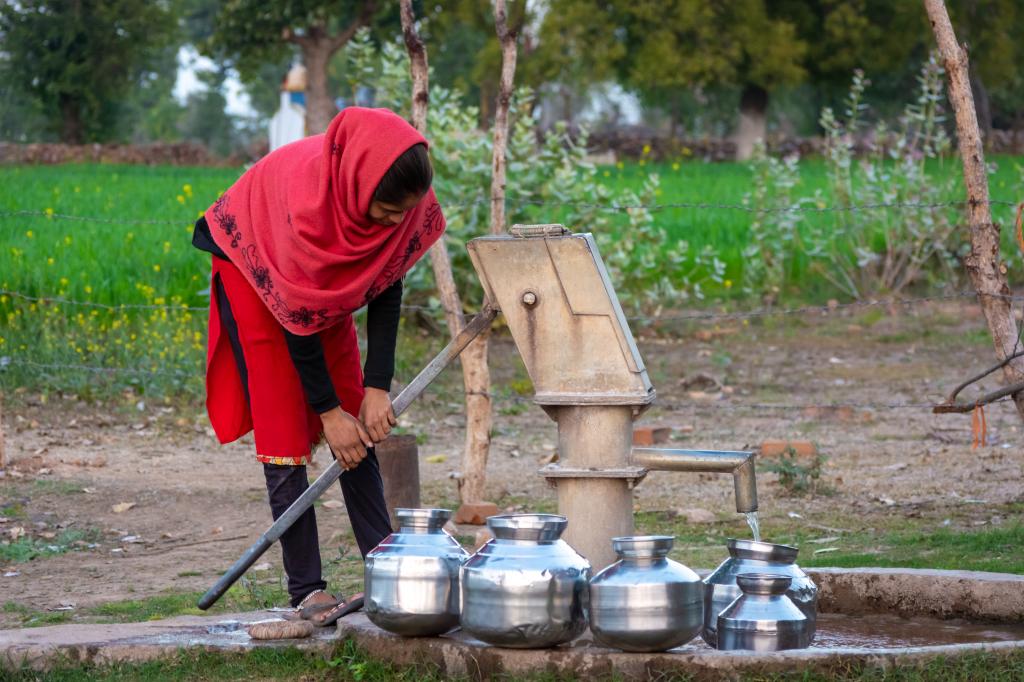The project exemplifies how methodical intervention can end supply problems even in hydro-geologically complex areas

Every summer, the borewells in Doralpally village in Vikarabad district of Telengana run dry. Each of the around 200 families in the village depend on these borewells constructed by the Gram Panchayat for water, said Yadaiah, a 40-year-old local farmer. “We would have to turn to government standposts during the five harsh summer months.”
The standposts are hardly a reliable and sufficient water source, Yadaiah added. The entire village has only three-four standposts, which have running water for less than an hour every day. “During the driest weeks, we had to go without water of three-four days at a stretch,” the farmer recalled.
Vikarabad was recently carved out of Rangareddy and Mahaboonnagar districts recently with 565 Gram Panchayats.
The area has a complex hydrogeological set-up: It is a hard rock terrain where the availability of groundwater is at a deeper level and recharge is challenging. On top of this, the district experiences deficient rainfall and there are no perennial water sources.
Vikarabad’s problems are also ailing every other district in Telangana.
The state’s declining groundwater challenge is augmented by the deteriorating quality of available resources. The fluoride content in groundwater is higher than permissible levels in 1,041 settlements spread over 28 of its 31 districts.

Mahabubnagar in south-west Telangana has the highest number (98) of fluoride-affected habitations in the state, according to the data available on the National Water Quality Sub-Mission dashboard.
It is followed by Vikarabad with 95 fluoride-affected habitations and Nalgonda with 80.
Efficient treatment plants
Telangana launched Mission Bhagiratha in 2015 to make drinking water sources safe and sustainable. The project is divided into 26 segments based on topography, command ability, proximity and ease of connectivity from various dependent sources.
The state has been tapping water from various reservoirs, projects and river flows, drawing from the basins of Krishna and Godavari.
The government gave permission to each reservoir management to maintain the minimum drawdown level, so that the required quantity of water can be stored for Mission Baghiratha even in lean years.

A functional water tap in a household in Godugonipally village, Vikarabad district. Photo: Faraz Ahmad
Around 50 water treatment plants (WTP) have been constructed across the state, one for each assembly constituency.
Each WTP consists of separate raw water and clear water systems. The raw water system comprises intake wells, raw water pump houses, overhead reservoirs and pipelines that carry water from the sources to the WTP.
The clear water system takes from WTPs to reservoirs at various points through a network of primary pipeline. Secondary pipelines emerging from this network distributes water to the over-head service reservoirs (OHSR) constructed in each habitation and linked to taps in each house.
The supply for 98 per cent habitations was designed in a way that would use topography and the force of gravity.
Two WTPs — at Raghavapura village in Vikarabad district and Kodangal village in Mahabubnagar district — were constructed, sourcing water from Srisailam and Yellore reservoirs.
Clean and safe water is supplied through Raghavapura reservoir to 740 habitations of Vikarabad district. The remaining habitations (216) meet their demand through Kodangal WTP.
Through these sources, 802,000 villagers in Vikarabad receive continuous supply of water, data provided by Vikarabad district office showed.
Assuring source sustainability
There is an in-house laboratory facility at the Raghavapura WTP, where the water quality after each process is monitored for the parameters such as Turbidity, pH and residual chlorine.
After ensuring the quality is safe at the last stage of the treatment process, water is supplied for users. The quality test is done every day.
Apart from the laboratory facility in WTP there are also several sub-divisional lab facilities to monitor the supplied water quality at the village-level for chemical and bacteriological contaminants.
G Subramaniam, deputy executive engineer and lab in-charge, Pargi sub-division laboratory, Vikarabad, said:
Every sub division has its own lab for sampling and analysis. In Pargi lab we are sampling and monitoring quality of 357 villages. Also, we undertake quality testing of 104 villages from Kodanagar sub division.
The water samples are taken from the source to the last point of the distribution, he added.
Earlier, there used to be outbreaks of diarrhoea, cholera and malaria every year, said Padma, the 30-year-old sarpanch of Baspally village in Vikarabad. “But since the mission was implemented, the health situation has improved in our village.”
Maintaining a regular supply of drinking water through laid down pipes is a problem that this mission helps circumvent, said Umashankar, assistant executive engineer, of the mission.
A ‘water man’ is appointed by every village by the gram panchayat who looks after the water supply schedule. In case of any technical issue, he reports to the gram panchayat officials.
The officials try to resolve the issue with their own funds and capacity. But if the issue is complicated, then it is reported to the sub-divisional engineers who take a maximum of 2-3 days, according to Umashankar.
There is also a bi-monthly checking of water supply pipes and water quality by the sub-divisional officers, said D Babu Srinivas, executive engineer, Mission Bhagiratha, Vikarabad District.
Mission Bhagiratha can also act as a model of successful implementation for the Jal Jeevan Mission, a central scheme aimed at providing tap water connection to every household in India. It can be particularly helpful to see how such schemes can be implemented in the challenging geography with scarce groundwater and surface water.
High levels of uranium in groundwater of eastern Karnataka’s 57 villages: Study
Uranium concentration in groundwater exceeded 30 ?g/l, more than the WHO-prescribed limit, in 57 out of 73 villages
By DTE Staff
Published: Thursday 16 December 2021

A chemical analysis of groundwater in 73 villages of Karnataka has found high levels of uranium concentration in groundwater of at least 57 villages.
The uranium concentration in these villages was at least 30 micrograms per litre (?g / l). In 48 of these villages, the levels exceeded 60 ?g / l.
In 78 per cent and 66 per cent of the villages studied, therefore, uranium concentration exceeded permissible limits given by the World Health Organization (30 ?g / l) and Atomic Energy Regulatory Board (60 ?g /l) respectively.
In one village each in Tumkur and Chitradurga districts, five in Kolar and seven in Chikkaballapura districts, uranium concentration was found to be in thousands of micrograms per liter, according to the study published in Current Science.
Uranium in drinking water raises concerns because of its chemical toxicity. Uranium (U) has no known essential biological functions. Chronic exposure to low-level U isotopes (radionuclides) may be interlinked with cancer etiology and at high exposure levels, also kidney disease.
The study was conducted by the scientists from the Divecha Centre for Climate Change, Indian Institute of Science and Centre for Advanced Research in Environmental Radioactivity, Mangalore University on uranium concentration in groundwater used for drinking purposes in 73 villages of Karnataka.
None of the borewells from which water has been sampled is anywhere in the vicinity of nuclear facilities or urban waste disposal channels, the study noted.
Repeat sampling was done in four localities in Chikkaballapur and Kolar districts to confirm the very high values of uranium that had been observed. The samples were collected between July and February.
Repeated analysis from all four localities confirmed a high abundance of uranium in groundwater. In addition, it showed that the samples collected during January and February had much higher uranium content than those collected during July.
Studies are underway to understand the pre- and post-monsoon compositional changes. Groundwater in Karnataka mainly circulates in the fractures of the saturated zone.
The soil-water and rock-water interactions play a major role in determining the chemical composition of water. Regional gamma-ray spectrometric studies indicate a higher abundance of uranium in gneisses (a type of rock) and granitoids (category of rock) of Eastern Dharwar Craton compared to those in Western Dharwar Craton.
Further, the soils in the eastern part of Karnataka being red loam with laterite at places, indicate a higher degree of oxidation during weathering. Oxidation of uranous to uranyl ion is promoted by such a weathering process.
As uranyl phases are soluble in circulating groundwater, the process leads to a higher concentration of dissolved uranium in groundwater. Such a process may play an important role in producing uranium-rich groundwater in eastern Karnataka.
There is also evidence that the water table is going down in many parts of eastern Karnataka. Oxidative weathering in the deeper levels is facilitated by this decline in groundwater level.
It also provides for an extended time of soil / rock-water interactions that lead to the release of more uranium to the circulating water.
